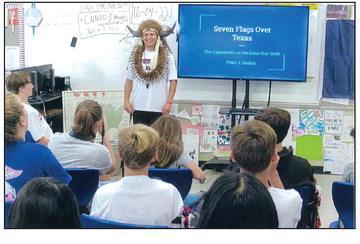SEVEN FLAGS OVER TEXAS
Texas History teacher Aaron Valero, of Danforth Middle School, hosted community volunteer Peter Durkin on Oct. 6, and he provided a powerpoint presentation to four classes of 7th grade Texas History students. These classes have been studying Texas Indians, and the Comanche certainly dominated this part of the world for many, many years.
Durkin explained that the Comanche people were related to the Shoshone people and migrated south to Texas in the 1600 and 1700’s. Writers such as T.R. Fehrenbach have dismissed the Comanche as “scattered bands of wanderers, never a nation.” Quite the opposite is true as described by Pekka Hamalainen in “Comanche Empire.” He wrote, “Comanches inverted the projected colonial trajectory through multifaceted power politics and brought much of the Southwest under their political, economic and cultural sway.” It was access to horses (around 1680) that spawned the military might of the Comanche people. The Comanche kept large herds of horses. It was not uncommon for a single Comanche to own more than 250 horses, a leader might own as many as 1,000. The Comanche consisted of 13 very loosely configured bands and lived on a vast territory called the Comancheria. On horseback the Comanche were described as “the greatest light cavalry,” utilizing bows and arrows and long lances to hunt and fight.
Further, the success of the Comanche as horseman helped spell their doom. “There had been too many Comanches (and their allies) raising too many horses and hunting too many bison on too small a land base.” Finally, powerful diseases, population pressure, technology such as the railroad, telegraph, the colt revolver and repeating firearms, and the industrial slaughter of the bison forced the Comanche out of Texas to Indian Territory, now the present southwest Oklahoma. Currently, there are approximately 17,000 Comanche tribal members. 7,000 reside in the Lawton-Fort Sill area of Oklahoma.
Valero and some of his students served as models for some of the material culture shared by Durkin. Durkin observed that, as always, “Wimberley students are active listeners and very courteous. I have a deep appreciation for our public school teachers and students - they have had to cope with the COVID pandemic and increased security requirements. I do envy their healthy cafeteria lunches that they can enjoy each day. Texas history is a complex topic with new insights thanks to gifted researchers and authors.”


